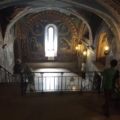Traveling from the Port of Jaffa (in present-day Tel-Aviv) to the Jaffa Gate (in Jerusalem) is an ancient Abrahamic custom –Jews going to the Temple, Christians visiting the Holy Places, and Muslims traveling to the Dome of the Rock, have walked this route for centuries.
After walking the Camino de Santiago, entrepeneurs Golan Rice and Yael Tarasiuk devoted themselvess to the recovery, signaling and promotion of the Way of Silence: the itinerary that pilgrims arriving from the Mediterranean used to get to Jerusalem.
The route starts at the old pier of the port of Jaffa. On the first day alone, a number of landmarks of capital importance for interreligious and intercultural dialogue can be visited: the Libyan Synagogue, the Church of Saint Peter, the Clock Tower, and the Siqsiq Mosque. The route covers 28 kilometers as it passes through Jaffa, Holon, Rishon LeZion, Beer Yaakov, and Ramla.
Sabil Abu Nabut is a significant stop on this unique camino. This is one of the many fountains that Ottoman rulers built specifically for pilgrims. Christians baptized it as the Tabitha’s Well, hinting at a miracle attributed to Saint Peter. According to the Acts of the Apostles, Peter himself ministered in this coastal region (ancient Lydda) before leaving for Rome.
The second day (14 km) departs from Ramla. Pilgrims walking through its streets and its Old Market have the chance to admire remarkable ancient buildings –including the noted White Tower, the Great Umari Mosque (originally, an ancient Crusader church dedicated to John the Baptist) and its impressive Pool of Arches: an underground, navigable water reserve built in the 7th century.
On the third day (17 km) pilgrims leave the urban areas. As they hike in the outskirts of these ancient cities, they walk towards the archaeological park of Tel Gezer, in the Ayalon Valley –the place where, according to Biblical narrative, Joshua commanded the moon to stop.
On the fourth day, silence begins. Covering 25 kilometers, the Way goes through the Trappist Abbey of Latrun, known for its library and vineyards. Another important Christian site is not too far away: Abu Ghosh, the ancient Emmaus. Once there, pilgrims visit its Benedictine Monastery and the Church of Our Lady of the Ark of the Covenant. Local tradition claims this is the place where the Ark of the Covenant was kept before King David decided to take it to Jerusalem.
The Saxum Center is well worth visiting. This is the exact point where the Way of Silence and the Emmaus Trail intersect. The center offers visitors a unique glimpse into the history of these lands through timelines, maps, interactive screens, models, recreations, and video mappings .
The fifth day of the road (15 km) will take you from Abu Gosh, through the ruins of the Belmont crusader fortress in Tel Tzuba, to another biblical Christian site, Ein Karem. According to tradition, this is where Mary visited her cousin Elizabeth, and also the area in which John the Baptist was born and raised. The Church of the Visitation and that of Saint John the Baptist are built on the spots where tradition claims these events took place. Pilgrims can also fill their bottles with water from Mary’s Spring.
Once in Ein Karem, pilgrims are just 12 kilometers away fro Jerusalem. Crossing the Jerusalem Forest, they enter Jaffa Street, passing by the emblematic Machaneh Yehuda Market and the Monastery of the Holy Cross, and finally reach the famous Jaffa Gate, which leads into the Christian Quarter of the Old City. There, pilgrims say goodbye as they reach the end of their shared journey. Some go to the Western Wall, others to the Holy Sepulchre, and others to the Dome of the Rock.




